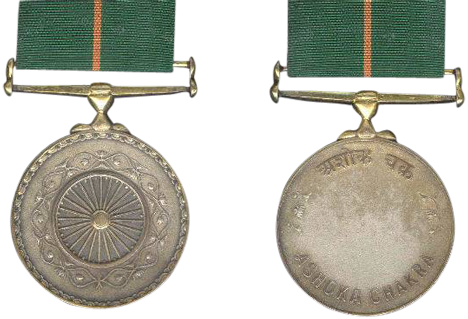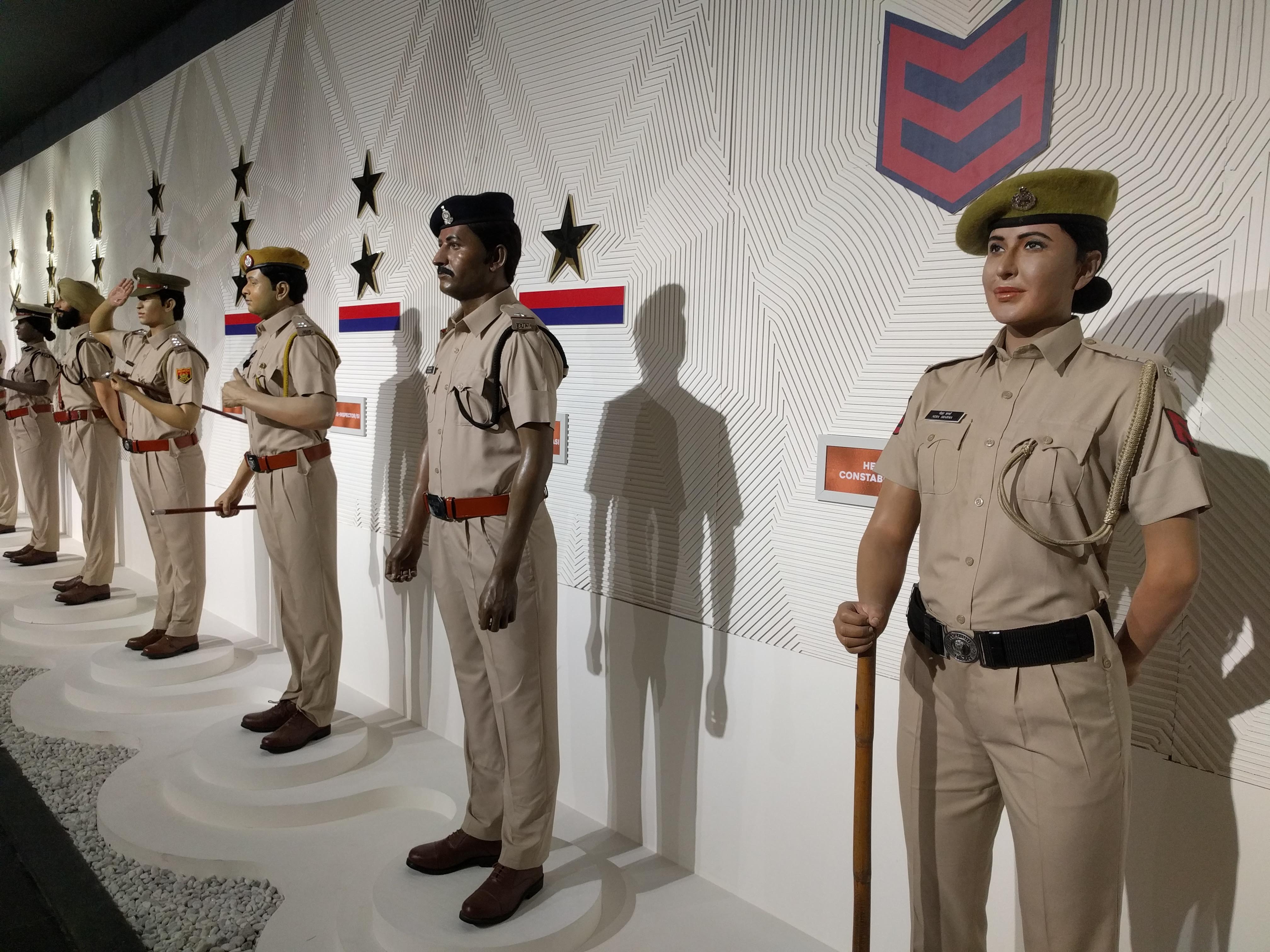|
K. Prasad Babu
KLVSNV Prasad Babu Ashoka Chakra Award, AC (1981 – 17 April 2013) was an Indian police officer belonging to the Greyhounds (Police), Greyhounds special operations group of the Andhra Pradesh Police. In 2013 he was posthumously awarded the Ashok Chakra Award, Ashoka Chakra, India's highest peacetime gallantry award, after he played a vital role in the death of nine Maoists and helped save the lives of four officers. Babu is the first-ever police officer from Andhra Pradesh to be awarded the Ashoka Chakra, which is usually conferred on soldiers. Personal life Prasad Babu was born in 1981 at Marturu, Visakhapatnam district, to Karanam Venkata Ramana Naidu and Satyavati. His full name is Karanam Leela Venkat Srihari Naga Varaprasad. His father Ramana is a retired circle inspector in the Andhra Pradesh Police. Police career Prasad Babu joined the Andhra Pradesh Police service in 2004 and was later transferred to the elite Greyhounds division. Prasad was the in-charge officer o ... [...More Info...] [...Related Items...] OR: [Wikipedia] [Google] [Baidu] |
Ashoka Chakra Award
The Ashoka Chakra (alternative spelling: Ashok Chakra) is India's highest peacetime military decoration awarded for valor, courageous action, or self-sacrifice away from the battlefield. It is the peacetime equivalent of the Param Vir Chakra (PVC) and is awarded for the "most conspicuous bravery or some daring or pre-eminent valour or self-sacrifice" other than in the face of the enemy. The decoration may be awarded either to military or civilian personnel. Naik Narbahadur Thapa, Havildar Bachittar Singh and Flight Lieutenant Suhas Biswas were the first recipients of the Ashoka Chakra. Subsequent awards of the Ashoka Chakra are recognized by a bar to the medal ribbon. A recipient can be awarded the Kirti Chakra or Shaurya Chakra in addition to separate acts of gallantry. History The medal was originally established on 4 January 1952 as the "Ashoka Chakra, Class I" as the first step of a three-class sequence of non-combatant bravery decorations. In 1967, these decorati ... [...More Info...] [...Related Items...] OR: [Wikipedia] [Google] [Baidu] |
Circle Inspector
Gazetted officers include all the Indian Police Service officers which are Class I officers of the cadre and all State Police Services (India), State Police Services officers of and above the rank of Deputy Superintendent of Police. All are arranged in a hierarchical order. Ranks of law enforcement in India The ranks, posts and designations of all police officers vary from state to state as law and order is a State list in India, state matter. But, generally the following pattern is observed: ;Gazetted Officers ;Non-gazetted officers Organisational structure and roles Overview Law enforcement in India is a State List, state matter. Hence, policing structure varies from state to state. But there is a general structure observed. Ministry of Home Affairs The Ministry of Home Affairs (India), Ministry of Home Affairs is in overall charge of internal as well as external security and policing and is the controlling authority for the Indian Police Service (IPS). Home Secretary, th ... [...More Info...] [...Related Items...] OR: [Wikipedia] [Google] [Baidu] |
Indian Police Officers
Indian or Indians may refer to: Peoples South Asia * Indian people, people of Indian nationality, or people who have an Indian ancestor ** Non-resident Indian, a citizen of India who has temporarily emigrated to another country * South Asian ethnic groups, referring to people of the Indian subcontinent, as well as the greater South Asia region prior to the 1947 partition of India * Anglo-Indians, people with mixed Indian and British ancestry, or people of British descent born or living in the Indian subcontinent * East Indians, a Christian community in India Europe * British Indians, British people of Indian origin The Americas * Indo-Canadians, Canadian people of Indian origin * Indian Americans, American people of Indian origin * Indigenous peoples of the Americas, the pre-Columbian inhabitants of the Americas and their descendants ** Plains Indians, the common name for the Native Americans who lived on the Great Plains of North America ** Native Americans in the Un ... [...More Info...] [...Related Items...] OR: [Wikipedia] [Google] [Baidu] |
2013 Deaths
This is a list of deaths of notable people, organised by year. New deaths articles are added to their respective month (e.g., Deaths in ) and then linked here. 2022 2021 2020 2019 2018 2017 2016 2015 2014 2013 2012 2011 2010 2009 2008 2007 2006 2005 2004 2003 2002 2001 2000 1999 1998 1997 1996 1995 1994 1993 1992 1991 1990 1989 1988 1987 See also * Lists of deaths by day The following pages, corresponding to the Gregorian calendar, list the historical events, births, deaths, and holidays and observances of the specified day of the year: Footnotes See also * Leap year * List of calendars * List of non-standard ... * Deaths by year {{DEFAULTSORT:deaths by year ... [...More Info...] [...Related Items...] OR: [Wikipedia] [Google] [Baidu] |
President Of India
The president of India ( IAST: ) is the head of state of the Republic of India. The president is the nominal head of the executive, the first citizen of the country, as well as the commander-in-chief of the Indian Armed Forces. Droupadi Murmu is the 15th and current president, having taken office from 25 July 2022. The office of president was created when India officially became a republic on 26 January 1950 after gaining independence on 15th August 1947, when its constitution came into force. The president is indirectly elected by an electoral college comprising both houses of the Parliament of India and the legislative assemblies of each of India's states and territories, who themselves are all directly elected by the citizens. Article 53 of the Constitution of India states that the president can exercise their powers directly or by subordinate authority (with few exceptions), though all of the executive powers vested in the president are, in practice, exercised by t ... [...More Info...] [...Related Items...] OR: [Wikipedia] [Google] [Baidu] |
Pranab Mukherjee
Dr. Pranab Mukherjee (11 December 193531 August 2020) was an Indian politician and statesman who served as the 13th president of India from 2012 until 2017. In a political career spanning five decades, Mukherjee was a senior leader in the Indian National Congress and occupied several ministerial portfolios in the Government of India. Prior to his election as President, Mukherjee was Union Finance Minister from 2009 to 2012. He was awarded India's highest civilian honour, the Bharat Ratna, in 2019, by his successor as president, Ram Nath Kovind. Mukherjee got his break in politics in 1969 when the then Prime Minister Indira Gandhi helped him get elected to the Rajya Sabha, the upper house of Parliament of India, on a Congress ticket. Following a meteoric rise, he became one of Gandhi's most trusted lieutenants and a minister in her cabinet in 1973. Mukherjee's service in a number of ministerial capacities culminated in his first stint as Finance Minister of India in 1982–84. H ... [...More Info...] [...Related Items...] OR: [Wikipedia] [Google] [Baidu] |
Pranab Mukherjee Giving Away The Highest Gallantry Award Ashok Chakra To Shri K
Pranab is an Indian name, common among Assamese, Bengalis, Odias and Nepalis. Notable people with the name include: * Pranab Bardhan (born 1939), Indian economist * Pranab Mukherjee (1935–2020), Indian politician * Pranab Roy Pranab Roy (born 10 February 1963) is a former Indian cricketer who played two Test matches for India. Early life He received his early education at Rama Chandra School in Kolkata. His father Pankaj Roy taught him cricket when he was 5 yea ... (born 1963), Indian cricketer {{given name Indian masculine given names ... [...More Info...] [...Related Items...] OR: [Wikipedia] [Google] [Baidu] |
Maoists
Maoism, officially called Mao Zedong Thought by the Chinese Communist Party, is a variety of Marxism–Leninism that Mao Zedong developed to realise a socialist revolution in the agricultural, pre-industrial society of the Republic of China and later the People's Republic of China. The philosophical difference between Maoism and traditional Marxism–Leninism is that the peasantry is the revolutionary vanguard in pre-industrial societies rather than the proletariat. This updating and adaptation of Marxism–Leninism to Chinese conditions in which revolutionary praxis is primary and ideological orthodoxy is secondary represents urban Marxism–Leninism adapted to pre-industrial China. Later theoreticians expanded on the idea that Mao had adapted Marxism–Leninism to Chinese conditions, arguing that he had in fact updated it fundamentally, and that Maoism could be applied universally throughout the world. This ideology is often referred to as Marxism–Leninism–Maoism to d ... [...More Info...] [...Related Items...] OR: [Wikipedia] [Google] [Baidu] |
Visakhapatnam District
Visakhapatnam district (formerly known as Vizagapatam district) is one of the six districts in the Uttarandhra region of the States and union territories of India, Indian state of Andhra Pradesh, headquartered at Visakhapatnam. It is one of the twenty-six List of districts of Andhra Pradesh, districts in Andhra Pradesh state.The district share broders with in the north and east, Vizianagaram district and South Anakapalli district in the south-west and Bay of Bengal in the south. History During the British Raj, British rule in India, Visakhapatnam emerged as a district in the year 1802. Chicacole (present-day Srikakulam) which was in Visakhapatnam district was incorporated into Ganjam when the latter was formed as a district. On 1 April 1936, Bihar and Orissa Province was split to form Bihar Province and Orissa Province. Parts of the Vizagapatam district (Madras Presidency), Vizagapatam district (i.e., Nabarangpur, Malkangiri, Koraput, Jeypore, Rayagada etc.) and the Ganjam ... [...More Info...] [...Related Items...] OR: [Wikipedia] [Google] [Baidu] |
Greyhounds (Police)
Greyhounds is a police special forces unit of the Andhra Pradesh and Telangana Police departments in India. Greyhounds specialises in counter-insurgency operations against Naxalite and Maoist terrorists. Several Indian paramilitary and police officers have described the Greyhounds as among the best anti-insurgency forces that specialises in anti-Maoist operations and as experts in jungle warfare. History Greyhounds was raised in 1989 by Indian Police Service officer K. S. Vyas. Directly as a consequence of founding the unit, Vyas became the top target on the Communist Party of India (Marxist–Leninist) People's War's hit list. Although he eventually was moved out of the Greyhounds, he continued to consult regularly on operations. Vyas was assassinated at gun point by Mohammed Nayeemuddin, and four other members of the CPI (M–L) People's War, on 27 January 1993 while taking an evening jog at Lal Bahadur Shastri Stadium in Hyderabad. Greyhounds commandos of Telangana Police ... [...More Info...] [...Related Items...] OR: [Wikipedia] [Google] [Baidu] |
Ashok Chakra Award
The Ashoka Chakra (alternative spelling: Ashok Chakra) is India's highest peacetime military decoration awarded for valor, courageous action, or self-sacrifice away from the battlefield. It is the peacetime equivalent of the Param Vir Chakra (PVC) and is awarded for the "most conspicuous bravery or some daring or pre-eminent valour or self-sacrifice" other than in the face of the enemy. The decoration may be awarded either to military or civilian personnel. Naik Narbahadur Thapa, Havildar Bachittar Singh and Flight Lieutenant Suhas Biswas were the first recipients of the Ashoka Chakra. Subsequent awards of the Ashoka Chakra are recognized by a bar to the medal ribbon. A recipient can be awarded the Kirti Chakra or Shaurya Chakra in addition to separate acts of gallantry. History The medal was originally established on 4 January 1952 as the "Ashoka Chakra, Class I" as the first step of a three-class sequence of non-combatant bravery decorations. In 1967, these decorations ... [...More Info...] [...Related Items...] OR: [Wikipedia] [Google] [Baidu] |




